Understanding the Best Beef Cuts for Steak
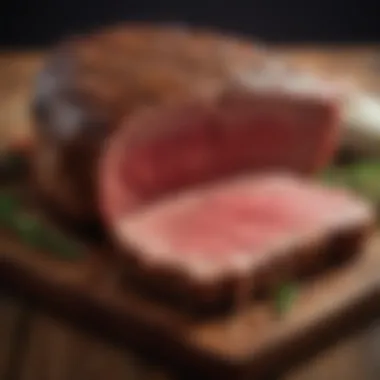
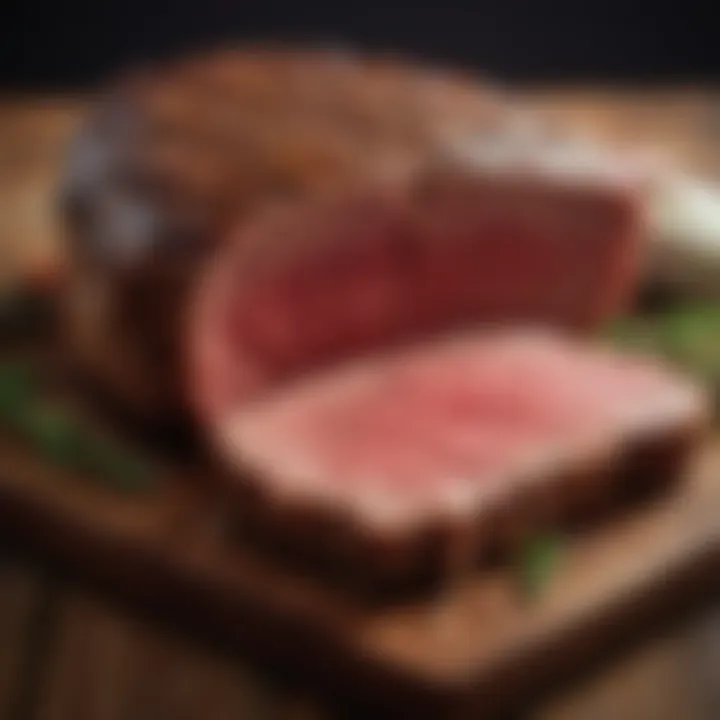
Intro
Selecting the right beef cut is essential for a great steak experience. Each cut has its own unique traits, affecting flavor, tenderness, and ideal cooking methods. The variations can be overwhelming, yet understanding them offers a rewarding advantage for any cook, beginner or expert. In this guide, we will explore top beef cuts, their characteristics, and preparations, enabling informed decisions for your next steak dinner.
To fully appreciate what each cut has to offer, it’s important to consider factors such as personal taste, cooking styles, and the occasion. Knowing what to look for when choosing beef can profoundly impact the outcome of your steak. The journey through the world of beef cuts will reveal nuances in textures and flavors, bringing a new depth to your cooking repertoire.
Foreword to Beef Cuts for Steak
Understanding beef cuts is essential for anyone who seeks to prepare a delicious steak. The right cut can greatly affect not just flavor and tenderness, but also cooking time and method. This section provides clarity on what makes each cut unique and why this knowledge is key to achieving a satisfying culinary experience.
When it comes to steak, not all cuts are created equal. Factors such as the location on the cow, muscle usage, and fat content play significant roles in determining the qualities of the beef. Cuts from more active muscles tend to be tougher but can offer profound flavor when cooked properly. In contrast, cuts from less active areas are often more tender. Therefore, knowing the characteristics of each cut allows cooks to choose wisely based on personal and guest preferences.
The benefits of understanding beef cuts extend beyond taste. One important consideration is cooking technique. Some cuts may be best suited for grilling, while others might require slow cooking methods to bring out their best qualities. For instance, a ribeye steak, known for its marbling, is ideal for high heat, while brisket benefits from a low and slow approach to achieve tenderness.
To enhance your steak dinner, consider the occasion. Different cuts cater to varied settings, from a casual family meal to an elegant dinner party. Understanding the nuances of beef cuts equips you to make informed choices that align with your cooking intentions.
In summary, grasping the fundamentals of beef cuts for steak is crucial for anyone seeking to elevate their culinary game. The right cut can influence the dining experience drastically, appealing to both the palate and the occasion.
"Selecting the right cut for your steak greatly influences the meal's overall quality and enjoyment."
With this foundational knowledge, you are better prepared to explore the specific cuts available, the factors that influence cut selection, and the techniques that will help you achieve the ideal steak.
Understanding Culinary Terminology
Understanding culinary terminology is essential for anyone interested in preparing steak. It allows individuals to communicate effectively about their preferences and cooking methods. Clear knowledge of terms associated with beef can guide cooks in selecting the right cuts and employing appropriate techniques.
In this article, we will focus on two main aspects of culinary terminology relevant to steak: the anatomy of beef and common terms associated with steak cuts. By familiarizing oneself with these concepts, cooks can navigate the wide range of beef options available and make informed decisions in their kitchens.
The Anatomy of Beef
The anatomical structure of beef refers to the various muscles and cuts that come from the cow. Each part of the animal offers distinct textures and flavors. For example, cuts such as filet mignon come from the tenderloin, a muscle rarely used by the animal, resulting in a very tender piece of meat. Conversely, the chuck section includes muscles that the cow uses more, which typically means more flavor but can also lead to tougher cuts.
Understanding these anatomical differences helps cooks select the right cut for their desired cooking method. The cattle have different sections:
- Chuck: This area comes from the shoulder and is often used for ground beef or slow-cooked dishes. The flavor is rich, but it may require longer cooking times to tenderize.
- Rib: This section houses cuts like ribeye and prime rib. They are well-marbled and tender, making them suitable for grilling or roasting.
- Loin: This is where the famous New York strip and tenderloin cuts are found. These are known for their tenderness and flavor, ideal for higher-end steak dinners.
- Round: Found near the back leg, these cuts, including top round and eye round, are leaner and can be tougher, making them best for specific cooking methods.
Increasing your knowledge about the anatomy of beef will improve your ability to choose the most suitable cuts for any meal.
Common Terms Associated with Steak
Familiarity with common culinary terms related to steak enhances both cooking and dining experiences. Some key terms include:
- Marbling: Refers to the intramuscular fat found within the meat. More marbling generally leads to more flavor and tenderness.
- Butchery: The skill of cutting meat into various portions and cuts. Different butchers may offer unique cuts based on their training and techniques.
- Aging: This process improves the tenderness and flavor of beef. It can be dry-aged or wet-aged. Dry aging involves hanging the beef in a controlled, chilled environment, while wet aging involves vacuum-sealing it in its own juices.
- Brining: Soaking meat in a saltwater solution helps to enhance flavor and moisture. This technique can be particularly beneficial for lean cuts.
Having a grasp of these terms allows cooks to make better choices and understand recipes more clearly. When discussing steak with others, it also encourages a shared understanding that enriches the culinary experience.
"An informed cook can elevate their steak game by comprehending the nuances of cuts and preparation methods."
This comprehension sets the foundation for effective cooking and enjoying steak at its best.
Overview of Popular Beef Cuts
The selection of beef cuts plays a significant role in achieving the ideal steak experience. Each cut of beef offers unique characteristics in terms of flavor, texture, and cooking properties. Understanding these differences is crucial for anyone interested in preparing steak, whether a home cook or a seasoned professional. This section provides an overarching view of popular beef cuts, focusing on their classification into tender and flavorful cuts. It aims to help you refine your choice based on preference and culinary intent.
Tender Cuts
Tender cuts are typically sourced from parts of the cow that experience less movement during its life. This lack of activity results in a softer texture, making these cuts highly sought after for steak preparations. Common examples include filet mignon and ribeye. These cuts naturally have a higher fat content, contributing both to their tenderness and rich flavor. Cooking methods that preserve the moisture and tenderness, such as grilling or searing, are highly recommended.
Additionally, tender cuts are often more expensive due to their popularity and limited supply. Investing in these cuts can be worthwhile, especially for special occasions or when quality is paramount. The enjoyment derived from a tender steak can elevate a meal from ordinary to extraordinary.
Characteristics of tender cuts:
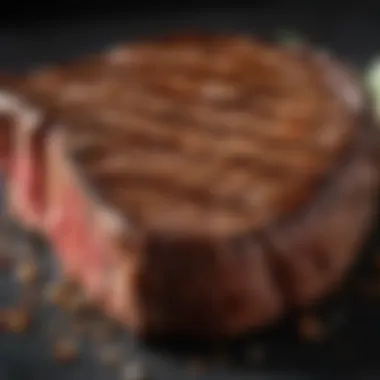
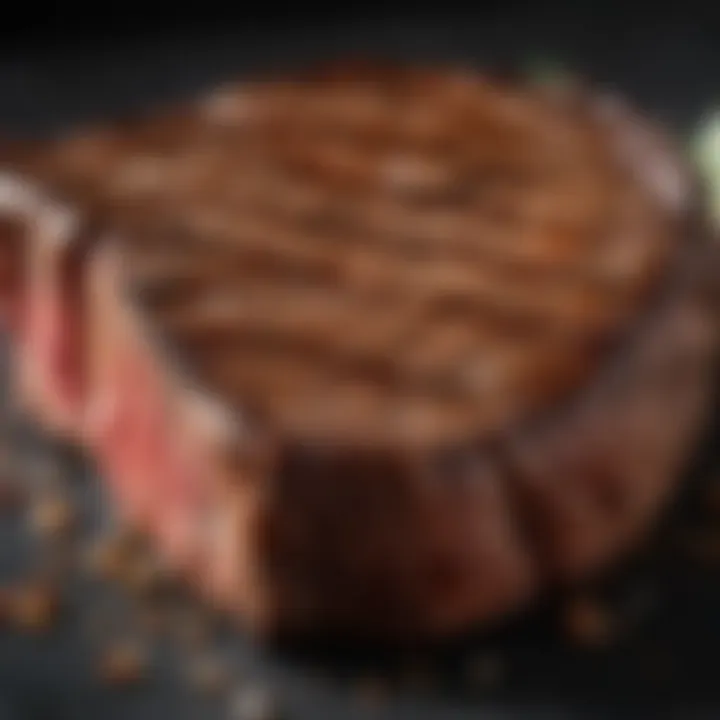
- Texture: Soft and juicy
- Fat Content: Higher, contributing to flavor
- Cooking Methods: Grilling, pan-searing, sous vide
Flavorful Cuts
Flavorful cuts come from areas that receive more exercise, such as the shoulders and legs of the cow. This increased activity enhances the flavor profile, but typically results in a firmer texture. Cuts like the New York Strip, sirloin, and flank steak belong to this category. Although they may be tougher than tender cuts, flavorful cuts often have a much richer and beefy taste.
Cooking these cuts usually requires techniques that tenderize, such as marinating or slow cooking. Preparing flavorful cuts can yield delicious results when proper methods are applied. They are often favored for more casual dining or barbecuing due to their robustness and affordability compared to tender cuts.
Characteristics of flavorful cuts:
- Texture: Firmer yet tasty
- Fat Content: Variable, usually leaner than tender cuts
- Cooking Methods: Marinating, slow cooking, grilling
"Understanding the differences between tender and flavorful cuts can greatly enhance your cooking experience and final dish quality."
Exploring Specific Cuts
Understanding the various cuts of beef is essential for any cooking enthusiast. Each cut has its own texture, flavor profile, and best cooking methods. This section will highlight specific cuts that are popular for steaks, allowing readers to make informed choices. Recognizing the purpose behind each cut can aid in preparing a meal that delights any palate. With knowledge of specific cuts, anyone can elevate their steak experience.
Filet Mignon
Filet mignon is often heralded as one of the most tender cuts of beef. It comes from the tenderloin, a muscle that does little work, resulting in a buttery texture. The flavor is milder compared to other cuts, which many find appealing. This cut is ideal for quick cooking methods, such as grilling or pan-searing, and is frequently served in upscale dining.
Consider serving filet mignon with a rich sauce, like a red wine reduction, to enhance its flavor.
Ribeye
Ribeye is known for its marbling and rich flavor. The fat interspersed within the muscle fibers contributes to its juiciness and tenderness when cooked. It can stand up to high-heat cooking methods, making it a popular choice for grilling. Ribeye is often described as having a beefy flavor, which some steak lovers seek out specifically.
A common method of preparation includes seasoning with simple salt and pepper to let its natural flavors shine.
New York Strip
The New York strip is a balance of tenderness and flavor. Cut from the short loin, it is firmer than filet mignon but still offers a satisfying chew. This cut has a robust flavor that pairs well with various marinades and seasonings. Grilling or broiling in the oven are effective cooking methods to ensure a good sear while retaining moisture.
When preparing New York strip, consider letting it rest post-cooking to maximize tenderness.
T-Bone and Porterhouse
Both T-bone and porterhouse cuts consist of a T-shaped bone with meat on either side, providing two eating experiences in one steak. The porterhouse is larger and includes a more substantial piece of tenderloin, whereas the T-bone offers a good portion of strip steak. Both cuts are flavorful due to their bone, which adds richness during cooking.
These cuts benefit from high-heat methods. Be cautious, as the larger size can lead to uneven cooking. It is best to use a meat thermometer to ensure proper doneness.
Sirloin
Sirloin falls between the tender cuts and flavorful cuts in terms of both tenderness and cost. It comes from the rear of the cow and offers a robust flavor. Sirloin can be grilled, sautéed, or roasted, making it versatile for various dishes.
For an optimal experience, marinate the sirloin before cooking to enhance its flavor profile and tenderness.
Brisket and Flank
Brisket and flank are often associated with slow cooking methods, as they require time to break down collagen. Brisket can be smoked or braised for maximum flavor, while flank steak is ideal for marinating and quick grilling. Both cuts are less tender than others but can provide deep, savory flavors when prepared correctly.
Using a slow cooker or a smoker can yield delicious results with these cuts, transforming them into melt-in-your-mouth creations.
Chuck Eye and Shoulder Cuts
Chuck eye and shoulder cuts are known for their affordability and rich flavor. These cuts benefit from marinating and slow cooking methods to enhance tenderness. Chuck eye, often referred to as "poor man's ribeye," is quite flavorful and can be grilled or roasted.
Incorporating these cuts into stews or braises can yield delightful dishes while being budget-friendly.
Understanding the variation in cuts allows chefs to make better choices, knowing how each cut will behave during cooking.

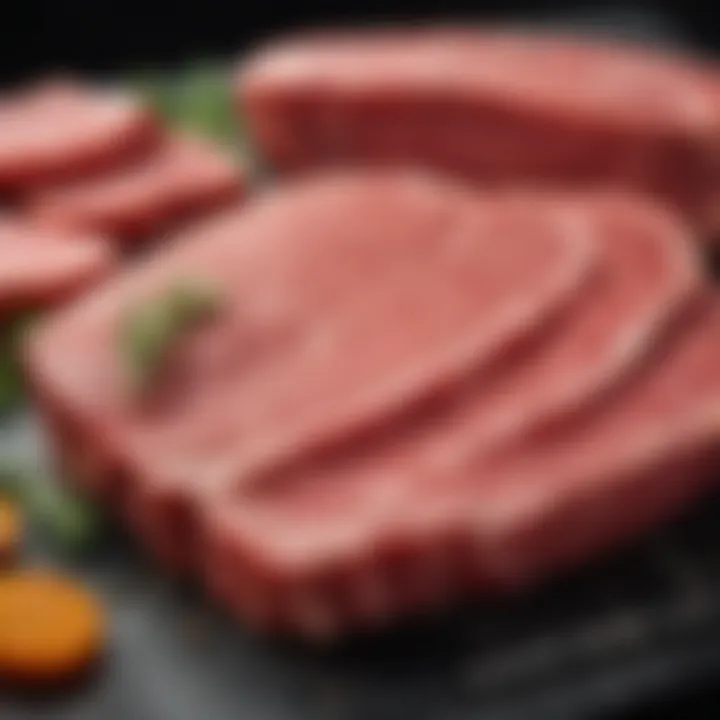
Factors Influencing Cut Selection
Selecting the right beef cut for steak involves understanding various factors that influence the decision. This is crucial not only for ensuring a delicious outcome, but also for matching the cut with the intended purpose and occasion. Making an informed choice can elevate a meal from ordinary to extraordinary.
When considering the cut, think about the texture, flavor, and tenderness that fits the dish you plan to prepare. Each cut has its unique characteristics influenced by the animal's age, breed, and even how it was raised. Therefore, it is essential to appreciate how these elements align with your culinary goals.
Purpose and Occasion
The purpose and occasion for which you are cooking is fundamental in determining the suitable beef cut. For instance, a casual family dinner might call for a more affordable cut like sirloin, which balances taste and budget. In contrast, a special celebration could merit the splurge on a filet mignon, which is one of the most tender cuts available.
Consider the following:
- Everyday Meals: Takes into account budget and ease of preparation. Cuts like chuck eye offer good flavor and tenderness.
- Special Occasions: Acknowledges moments that warrant memorable meals. Ribeye or porterhouse may be the go-to choices as they are rich in flavor and visually impressive.
- Grill Outs: Casual gatherings often favor steaks that hold up well over high heat, like flank or skirt steak. They can be both flavorful and cost-effective when serve to a group.
Recognizing the needs of the occasion guides the selection process effectively, ensuring a better experience for both the cook and the guests.
Budget Considerations
Budget is a significant aspect that must be taken into account when choosing a beef cut. The variation in price typically correlates with the cut’s tenderness and flavor profile. Understanding these price points enables more informed selection aligned with financial constraints without compromising quality.
When evaluating your budget, it is beneficial to:
- Research Affordable Cuts: Familiarize yourself with cuts such as flank or chuck roast. These can often provide good flavor without the premium price.
- Consider Portion Sizes: Generally, more expensive cuts are more tender, requiring less cooking time. Thus, smaller portions can often suffice.
- Buy in Bulk: Purchasing larger cuts can often mean savings over time. Cuts like brisket can be split and prepared in various ways.
Ultimately, integrating budget considerations with specific needs ensures a well-rounded steak experience without financial strain.
Cooking Techniques for Steak
Cooking techniques for steak are critical to achieving the desired flavor and texture. Each method offers a unique way to enhance the qualities of the beef cut. The right cooking technique can make an ordinary cut taste extraordinary. Understanding how different techniques work and what flavors they bring out can elevate your steak experience.
Grilling
Grilling is one of the most popular techniques for cooking steak. It allows for high heat cooking that can create a delicious crust while sealing in juices. The flames and smoke add a distinct flavor. To achieve the best results, preheat the grill and ensure your steak is at room temperature before cooking.
A key consideration in grilling is the thickness of the steak. Thicker cuts benefit from direct heat for a short period followed by indirect heat to allow for even cooking. This method helps prevent drying out. Remember to let the steak rest after grilling, allowing the juices to redistribute.
"Resting the steak after cooking is essential to maintaining its juiciness."
Searing and Pan-Frying
Searing steak in a hot pan is an effective way to lock in moisture and create a rich, flavorful crust. Choose a heavy skillet, ideally cast iron, for excellent heat retention. Ensure the pan is hot before adding the steak. This method can be used for both thin and thick cuts.
When pan-frying, it is important to not overcrowd the pan. This can lead to steaming rather than searing. Additionally, using a mixture of fats can enhance flavor. Butter, for example, can be added towards the end of cooking for a rich finish. Let the steak rest after cooking to keep it moist.
Roasting
Roasting is another technique particularly suited for larger cuts of steak. This method employs even heat throughout, often in an oven. The key is to start with high heat to develop a crust, then reduce the temperature to cook through.
For best results, season the steak liberally and consider using a meat thermometer to monitor doneness. Roasting is advantageous because it allows for less active cooking time. You can prepare side dishes or sauces while the steak cooks, making it efficient for larger meals.
Sous Vide Cooking
Sous vide cooking offers precision that other methods may not. This technique involves vacuum-sealing the steak in a bag and immersing it in a water bath at a consistent temperature. The result is a steak that is evenly cooked from edge to edge, retaining moisture and flavor.
One major benefit of sous vide is flexibility. You can cook the steak for an extended time without overcooking. Once removed from the water bath, a quick sear in a hot pan can create the desired crust. This method requires planning, but it yields excellent results that are difficult to achieve with other techniques.
Understanding Doneness Levels
Understanding doneness levels is crucial for making a perfect steak. It shapes not only the texture but also the flavor and overall culinary experience. Each level of doneness represents a different internal temperature, impacting how the meat is perceived on the palate. When one pays attention to doneness, it can enhance the perceived quality of the steak. A well-cooked steak can elevate a meal from ordinary to extraordinary.
Different doneness levels are suited for various cuts of meat. For instance, a tender cut, such as Filet Mignon, may be better appreciated when cooked to a medium rare, showcasing its tenderness. On the other hand, a flavorful cut like Ribeye could benefit from a medium or medium-well doneness to allow the fat to render properly.
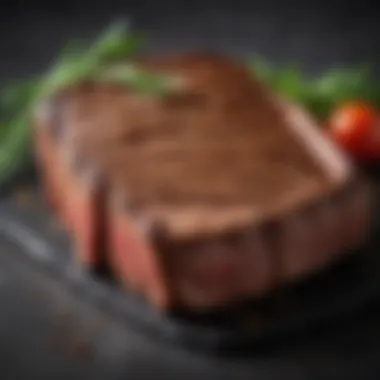
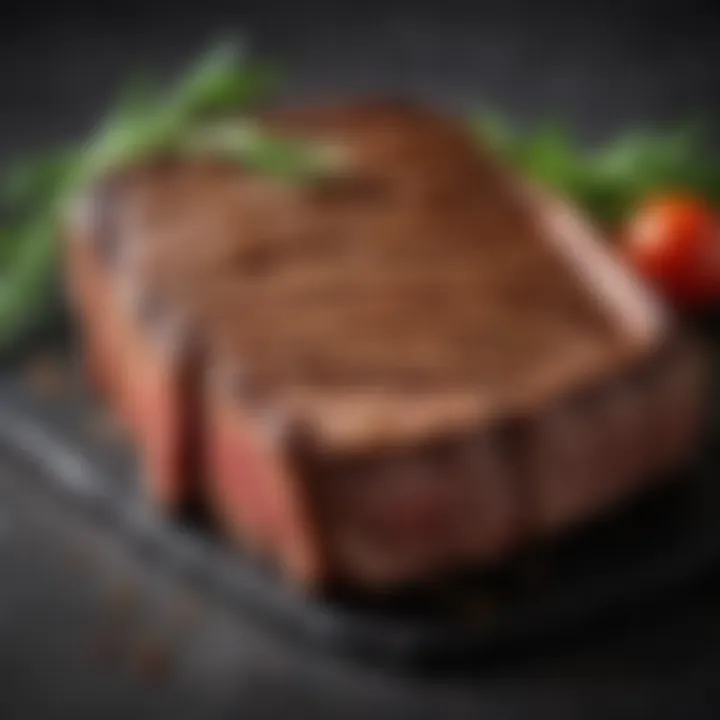
Rare to Medium Well
The doneness spectrum ranges from rare, with an internal temperature of about 125°F (52°C), to medium well, reaching approximately 150°F (66°C). Let’s break down these key levels:
- Rare (125°F / 52°C): The center is cool and red. This level holds maximum juiciness but may not be suitable for everyone due to food safety concerns.
- Medium Rare (135°F / 57°C): A warm red center, this level is often considered optimal for quality cuts. It retains flavor and tenderness while developing some crust from cooking.
- Medium (145°F / 63°C): The center is pink and firm. It offers a nice compromise in terms of juiciness and flavor.
- Medium Well (150°F / 66°C): Only a hint of pink remains, providing a firmer texture. Although it retains some moisture, the flavor may not be as rich as in the previous levels.
Everyone has their preference for steak doneness. Some appreciate the full flavor spectrum available at medium rare, while others prefer the more cooked offerings at medium well. It’s important to know that cooking times will vary based on the thickness of the cut and the heat source being used.
Using a Meat Thermometer
A meat thermometer is an indispensable tool when it comes to achieving the desired doneness. It ensures accuracy in internal temperature readings while mitigating the risk of undercooking or overcooking. Here are a few key benefits of using a meat thermometer:
- Precision: It provides an accurate measurement, reducing uncertainty in the cooking process.
- Safety: By reaching the appropriate internal temperatures, it helps to minimize foodborne illnesses.
- Consistency: Using a thermometer allows one to replicate results, ensuring the same doneness level is achieved every time.
To use the thermometer effectively, insert it into the thickest part of the cut, avoiding bone if present. Wait a few seconds for the reading to stabilize. For a more reliable assessment, remove the steak from heat a few degrees before your target temperature, since residual heat can continue to cook the meat.
"A quality steak cooked to the right doneness is enjoyable, but one that has reached the wrong temperature can ruin the entire experience."
Pairing Steak with Sides and Sauces
Pairing steak with sides and sauces is an essential aspect of elevating the steak-eating experience. The right combination can enhance the flavors of the steak while providing balance to the meal. Each side dish and sauce contributes unique elements that complement the richness of steak, allowing the diner to explore different textures and tastes.
When considering sides, one has to think about contrasting and complementary flavors. For instance, a rich ribeye steak might be beautifully paired with roasted vegetables. The earthiness of carrots and Brussels sprouts acts as a counterbalance to the steak's savory profile. Alternatively, a creamy mashed potato can offer a smooth consistency that works well with any juicy cut, absorbing the meat juices and sauce effortlessly.
Moreover, sauces can amplify the steak's attributes. A classic chimichurri adds herbaceous vibrancy, cutting through the richness of the meat. A rich béarnaise sauce, on the other hand, enhances the flavor profile with its buttery texture and rich ingredients.
"The synergy between a steak and its accompaniments is essential for a satisfying meal. Choosing wisely can turn a simple dinner into a memorable feast."
Considerations must also include the recipe and attributes of the steak chosen. Some cuts lend themselves better to specific flavor profiles. For example, a lighter cut like filet mignon can flavor well with lighter sauces, while a stronger cut like flank or skirt steak can handle more intense seasoning and sides.
Complementing Flavors
To create a harmonious plate, you need to focus on flavor balance. Combining bold and subtle flavors is key. Here are some ideas for pairing:
- Vegetable Sides: Grilled asparagus, sautéed green beans, or caramelized onions can enhance the meat's savory taste without overpowering it.
- Potatoes: Options include classic roasted potatoes or twice-baked variations that provide texture.
- Grains: Adding a side of quinoa or rice pilaf can offer a light, nutty contrast.
When choosing sauces, think about both flavor complexity and texture. Mustard sauces, steak sauces, and reductions can provide a depth of flavor that matches the steak quality. Simple herb infusions or butter toppings also serve to lift the overall profile of the meal.
Wine and Beverage Suggestions
Selecting the correct beverage to accompany a steak dinner is vital. Wines have the ability to enhance the flavors of both the meat and the accompanying sides, creating a harmonious meal. Red wines typically pair well with steak. For example, a Cabernet Sauvignon is known for its bold flavor and tannins, which complement the richness of a ribeye beautifully.
Other options include:
- Merlot: A softer choice that pairs well with most cuts.
- Syrah/Shiraz: Offers peppery notes that can enhance a grilled steak.
- Malbec: Versatile and fruity, making it a fine match for most beef cuts.
Beer can also be an appropriate choice. A robust stout or a hoppy IPA can provide an interesting balance to steak flavors.
Ultimately, the goal is to create a well-thought-out meal where each component supports the others. By carefully selecting sides and beverages, one can achieve an exceptional steak dinner that emphasizes the quality of the meat while offering a delightful culinary experience.
For further reading on pairings, you might find some interesting suggestions on Wikipedia or discussions about steak on Reddit.
Final Thoughts on Choosing the Right Cut
Choosing the right cut of beef for steak is not just a matter of personal preference but also one of culinary strategy. Each cut comes with its unique characteristics and applications, which can significantly affect the cooking process and the final dish. Factors such as texture, flavor, and purpose all play a critical role in your decision-making. Understanding these elements allows you to align your selection with the desired outcome, whether that's a casual barbecue or a formal dinner.
One important consideration is the balance between tenderness and flavor. More tender cuts like Filet Mignon provide a melt-in-your-mouth experience, but they can sometimes lack the robust taste found in cuts like Ribeye, which are well-marbled and full of flavor. The best steak experience often arises from understanding this trade-off and selecting accordingly.
Furthermore, beef cuts vary in terms of cooking methods. For instance, a T-Bone steak is ideal for grilling due to its versatility and ability to create a nice crust, while a Brisket may be better suited for low and slow cooking methods like smoking or braising. Knowing these cooking techniques can help ensure that the cut is cooked to perfection.
Key Takeaway: The choice of steak cut should depend on multiple factors, including the occasion, desired flavor profile, and cooking methods.
When considering budget, it’s essential to recognize that higher price does not always equate to a better cut. There are flavorful options that are more economical, like Sirloin or Chuck Eye, that deliver satisfying results without breaking the bank. By weighing these factors together, you can optimize your steak experience both in terms of quality and cost-effectiveness.
Always take into account the preferences of those who will be enjoying the meal. Some may favor leaner cuts, while others prefer those that are more fatty and rich in taste. Holding a dialogue about these preferences can guide you in making the best selection.
In summary, the quest for the perfect steak cut involves careful consideration of various elements. Incorporating an understanding of anatomy, texture, flavor, cooking techniques, and cost can greatly enhance your culinary endeavours. In the realm of beef, knowledge is power, informing every step from selection to plate.







